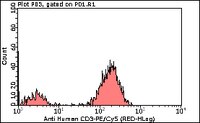The T cell receptor: critical role of the membrane environment in receptor assembly and function.
Call, Matthew E and Wucherpfennig, Kai W
Annu. Rev. Immunol., 23: 101-25 (2005)
2005
Show Abstract
Recent studies have demonstrated that cell membranes provide a unique environment for protein-protein and protein-lipid interactions that are critical for the assembly and function of the T cell receptor (TCR)-CD3 complex. Highly specific polar interactions among transmembrane (TM) domains that are uniquely favorable in the lipid environment organize the association of the three signaling dimers with the TCR. Each of these three assembly steps depends on the formation of a three-helix interface between one basic and two acidic residues in the membrane environment. The same polar TM residues that drive assembly also play a central role in quality control and export by directing the retention and degradation of free subunits and partial complexes, while membrane proximal cytoplasmic signals control recycling and degradation of surface receptors. Recent studies also suggest that interactions between the membrane and the cytoplasmic domains of CD3 proteins may be important for receptor triggering. | 15771567
 |
Function of the Src-family kinases, Lck and Fyn, in T-cell development and activation.
Palacios, Emil H and Weiss, Arthur
Oncogene, 23: 7990-8000 (2004)
2004
Show Abstract
The function of the Src-family kinases (SFKs) Lck and Fyn in T cells has been intensively studied over the past 15 years. Animal models and cell line studies both indicate a critical role for Lck and Fyn in proximal T-cell antigen receptor (TCR) signal transduction. Recruited SFKs phosphorylate TCR ITAMs (immunoreceptor tyrosine-based activation motifs) in the CD3 and zeta chains, which then serve as docking sites for Syk-family kinases. SFKs then phosphorylate and activate the recruited Syk-family kinase. Lck and Fyn are spatially segregated in cell membranes due to differential lipid raft localization, and may undergo sequential activation. In addition to the CD4 and CD8 coreceptors, a recently described adaptor, Unc119, may link SFKs to the TCR. CD45 and Csk provide positive and negative regulatory control of SFK functions, respectively, and Csk is constitutively bound to the transmembrane adapter protein, PAG/Cbp. TCR-based signaling is required at several stages of T-cell development, including at least pre-TCR signaling, positive selection, peripheral maintenance of naive T cells, and lymphopenia-induced proliferation. SFKs are required for each of these TCR-based signals, and Lck seems to be the major contributor. | 15489916
 |
Molecular mechanisms for the assembly of the T cell receptor-CD3 complex.
Call, Matthew E and Wucherpfennig, Kai W
Mol. Immunol., 40: 1295-305 (2004)
2004
Show Abstract
The T cell receptor (TCR)-CD3 complex represents on of the most intricate membrane receptor structures since it is built from six distinct chains. This complexity led to a number of different proposals for the arrangement of the receptor subunits, its stoichiometry and the mechanisms responsible for receptor triggering. Early work had demonstrated that basic and acidic transmembrane (TM) residues were involved in the assembly but the molecular arrangement could not be deduced due to the complexity of the receptor. Using a novel method for the isolation of intact radiolabeled protein complexes, we demonstrated that the complex assembled in the ER contains only a single TCRalphabeta heterodimer and one copy of each of the CD3deltaepsilon, CD3gammaepsilon and zeta-zeta signaling dimers. Surprisingly, assembly of each of the three signaling dimers with TCR was dependent on one of the three basic TCR TM residues as well as both acidic residues located in the TM domains of the interacting signaling dimer. Each assembly step thus results in the formation of a three-helix interface in the membrane that involves one basic and two acidic TM residues, and this arrangement effectively shields these ionizable residues at protein-protein interfaces from the lipid. Since proteins whose TM domains have exposed ionizable residues are not stably integrated into the lipid bilayer, assembly based on shielding of ionizable residues permits full equilibration of the receptor into the lipid bilayer and prevents degradation. Assembly, export of intact receptor complexes and degradation of unassembled components thus rely on the same organizing principle. | 15072848
 |
Signaling life and death in the thymus: timing is everything.
Werlen, Guy, et al.
Science, 299: 1859-63 (2003)
2003
Show Abstract
T lymphocytes are generated in the thymus, where developing thymocytes must accept one of two fates: They either differentiate or they die. These fates are chiefly determined by signals that originate from the T cell receptor (TCR), a single receptor complex with a remarkable capacity to decide between distinct cell fates. This review explores TCR signaling in thymocytes and focuses on the kinetic aspects of ligand binding, coreceptor involvement, protein phosphorylation, and mitogen-activated protein kinase (MAPK) activation. Understanding the logic of TCR signaling may eventually explain how thymocytes and T cells distinguish self from nonself, a phenomenon that has fascinated immunologists for 50 years. | 12649474
 |












